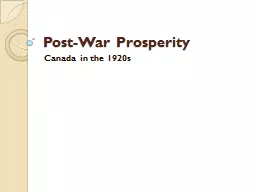PPT-Post-War Prosperity
Author : min-jolicoeur | Published Date : 2018-01-03
Canada in the 1920s After World War One When the First World War ended in 1918 many Canadians hoped life would return to normal However during WW1 most of the economy
Presentation Embed Code
Download Presentation
Download Presentation The PPT/PDF document "Post-War Prosperity" is the property of its rightful owner. Permission is granted to download and print the materials on this website for personal, non-commercial use only, and to display it on your personal computer provided you do not modify the materials and that you retain all copyright notices contained in the materials. By downloading content from our website, you accept the terms of this agreement.
Post-War Prosperity: Transcript
Download Rules Of Document
"Post-War Prosperity"The content belongs to its owner. You may download and print it for personal use, without modification, and keep all copyright notices. By downloading, you agree to these terms.
Related Documents














